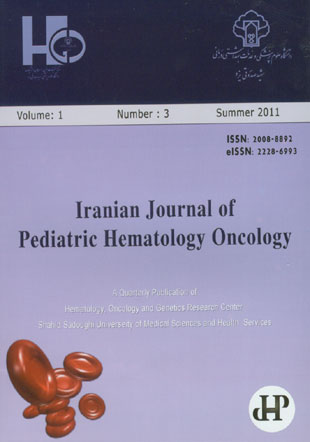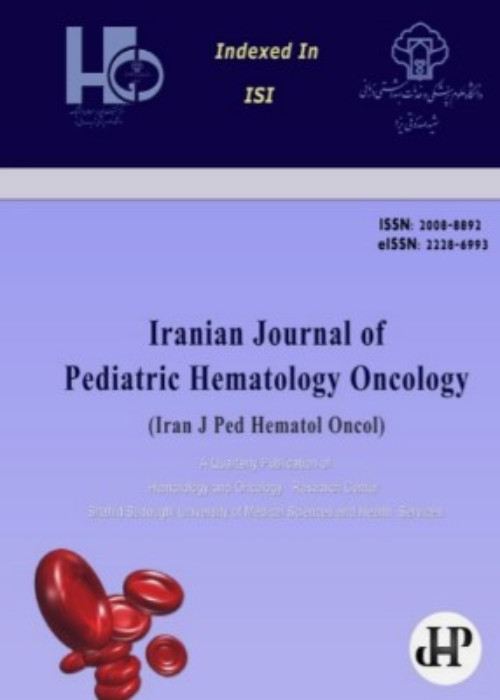فهرست مطالب

Iranian Journal of Pediatric Hematology and Oncology
Volume:1 Issue: 3, Summer 2011
- تاریخ انتشار: 1390/07/01
- تعداد عناوین: 8
-
-
Page 71BackgroundLeukemia is the most prevalent childhood cancer and Acute Lymphoblastic Leukemia (ALL) constitutes 75% of all cases. The most frequent presenting symptoms are fever, weight loss and pallor. Early detection of clinical symptoms positively affects timely diagnosis. The objectives of the present study were to assess frequency of presenting symptoms, laboratory data, immune phenotypes and prognostic factors in children with diagnosis of ALL. Materials and MethodsWe performed a prospective follow-up study of 100 patients aged 1-16 years diagnosed with ALL, admitted to Shahid Sadoughi hospital pediatrics ward from March 2006 to February 2010. Demographic and biochemical data were obtained from their medical record. Data were analyzed using SAS 9.1.3 software.ResultsThe mean of patients’ ages was 9 years. Complete blood cell count was abnormal in all of the patients, and pancytopenia was detected in 27% of the patients. Of all the patients, 25% had abnormal white blood cell (WBC) count at presentation, 37% had leucopenia and 38% had leukocytosis. WBC count was above 50,000/mm³ in 22% of cases. Anemia was detected in 85% of the patients. There was no significant sex difference, but a significant age difference existed among patients (p <. 05).According to flowcytometry results, 61% of patients had T-cell and 39% had B-cell immune phenotype. The frequency of undesirable prognostic factors was more in T-cell than the B-cell group, but this difference was only significant for male patients (p<0.05).The most common presenting symptoms were systemic symptoms, which comprised of lethargy and malaise in 81%, anorexia in 72%, pallor in 69% and fever in 59% of cases. Musculoskeletal system was the most common system involved.ConclusionIn our study, T-cell immune phenotypes comprised the most frequent form of ALL in children. The presence of male sex and high WBC count could make its outcome worse. However, on time chemotherapy could alter the outcome of these patients.
-
Page 78ObjectiveThe great majority of patients with childhood leukemia become long-term survivors. They treated with chemotherapy and prophylactic central nervous system (CNS) irradiation. The aim of this cross-sectional study was to evaluate effect of the long-term toxicity in ALL survivors, and possible effects of this treatment on their intellectual in compare with their sibling.Materials and Methods In this case-control study 40 children, 20 ALL patients and 20 their sibling, were evaluated. This study chose 20ALL patients, which they sibs were 1 or 2 years younger or older and same sex. Patients were diagnosed in Shahid Saduoghi hospital and treated with single chemotherapy (systemic and intrathecal) and radiation therapy (1800 rad).Variables such as age, treatment outcome, genesis and the effect of prophylactic treatment of the CNS on the intellectual function of ALL patients were studied and compare with their healthy sibling by Wechsler intelligent test.ResultsAge range was between 6 to12 years old. The mean verbal IQ score for patients was 113.25+/-13.35 and in their sibling was 113.25+/-14.74. (p=1), therefore the differences was not significant.ConclusionThe mean verbal IQ score for patients that received low dose radiotherapy was in the average range. These preliminary findings provide direction for future studies to help identify high-risk patients.
-
Page 83ObjectiveRemoving plasma from the platelet concentrate (PC) medium could be an effective way to increase the safety of this product. The goal of this study was to compare PC stored in plasma or in an additive solution (Composol) with in vitro testing. Materials and MethodsFifty-four single donor PCs were prepared from Iranian Blood Transfusion Organization (IBTO). Each PC unit was divided into two portions. Then in one of the portions, plasma was replaced with Composol. Sampling was carried out at the days 2, 4 and 7 from the preparation time. The levels of pH, glucose, lactate and lactate dehydrogenase (LDH) were analyzed by colorimetric methods. ResultsThe levels of pH and glucose were decreased during storage whereas the levels of LDH and Lactate were increased with time over. At the day 7 of storage, the mean values for glucose were 404.44 and 25.19 mg/dl in plasma and Composol, respectively. These values were 3306.1 and 683.33 U/L for LDH and 142.07 and 90.90 mg/dl for lactate. The differences between LDH, lactate, and glucose levels were significant between the two storage media of plasma and Composol (P-value<0.001).ConclusionThis study could imply the potential capacity of an additive solution as a candidate for plasma replacement in PC in vitro.
-
Page 90BackgroundBrucella mellitensis, the most invasive strain of brucella, is the predominant Strain of genus brucella in Iran. It causes variety of hematological abnormalities some of which are frequent and causes difficulties in diagnosis.ObjectiveTo find hematological abnormalities of brucellosis in hospitalized patients in an endemic area. Materials and MethodsA retrospective review of patient's medical records who were admitted to four university and general hospitals during 8 years was done. Age, sex, clinical findings, laboratory tests including CBC, platelet count, Erythrocytic Sedimentation Rate (ESR), C-Reactive Protein, wright test were assessed. Confirmation of brucellosis was made by wright agglutination test at a titer; ≥1/160. Data were analyzed by Spss16 and Pvalue <0.05 was taken as significant for differences.ResultsOut of 238patients diagnosed as brucellosis, hematologic evaluation had been performed for 208patients.Anemia was detected in (55/119)46%of male and (35/89) 39.3% of female patients (Pvaule0.383). Leukopenia (WBC < 4300/mm3) was present in (18/208) 8.5%, thrombocytopenia (Platelet < 150.000/ mm3) in (24/200) 12% and pancytopenia in (3/200) 1.5%of patients.ConclusionBrucellosis should be considered in differential diagnosis of any patient with disturbances of hematologic findings in endemic areas.
-
Page 94Objective Cardiac dysfunction is a major cause of death in patients with beta thalassemia. In these patients, repeated blood transfusion, ineffective erythropoiesis and increased gastrointestinal iron absorption lead to iron overload in the body and this induced heart failure. Left ventricular ejection fraction was measured in major beta thalassemia (β-Th) patients to detect the relation of serum ferritin level and left ventricular systolic function.Materials and Methods The present prospective study evaluated 75 patients with β-thalassemia (39 female, 36 male) aged one to 44 years old. They were treated with desferal 5 days a week for at least six months. For this study they treated by desferal 7 days a week. Left ventricular ejection fraction and serum ferritin were measured before and after intervention, and they were compared for the best treatment. ResultsThe mean ejection fraction was 60.45% and 62.9% before and after aggressive therapy, which difference was significant. Serum ferritin level also was reduced after intervention. Difference between mean ferritin before and after intervention was 49.984. Serum ferritin showed negative correlation with left ventricular function. ConclusionLower serum ferritin concentration with aggressive therapy was associated with better left ventricular function.
-
Page 98BackgroundThalassemia is one of the most common human genetic diseases in the world and it provides many problems for patients, families and health care system. This model helped the family with sick children to empower to face disease and its complications. To reach this aim, the knowledge and attitude of patients and their families about the disease should be increased. This study was aimed at determine the effectiveness of family-centered empowerment model on the mothers’ knowledge and attitudes about thalassemia disorder.ObjectiveTo assess the effect of family-centered empowerment model on the mothers knowledge and attitudes about thalassemia disorder in children with thalassemia.Materials and methodsThis semi-experimental study was performed on 86 children with thalassemia that were randomly divided into two groups. A questionnaire was filled with demographic information and knowledge and attitude of the mothers about the disease. These questionnaires were tested for content validity and reliability (internal correlation). Information was given to first group and second group did not receive any more information. After intervention final evaluation was performed one and half month later.ResultsData analysis showed that before intervention, the average awareness and attitude of the mothers in test group were no significantly different with control group (p>0.05). However, after performing model in the test group, this averages were significantly higher in test group than control (p<0.05).ConclusionsThe results of this study indicated that implementation of the family-centered empowerment model are effective on knowledge and attitudes of mothers of children with thalassemia.
-
Page 104ObjectiveImmune thrombocytopenic purpura (ITP) manifests as an easy bruising or extravasation of blood from capillaries into skin and mucous membranes. The characteristics of acute ITP in infants have rarely been described. In order to better understand acute ITP in infants, the characteristics of the disease at this age group was investigated.Material and MethodsThe present descriptive, cross-sectional study, variables such as age, sex, clinical presentation, treatment outcome, and the rate of chronicity in 72 infant suspected to ITP on admission were evaluated from 2002 to 2008 at Yazd Shahid Sadoughi Hospital.ResultsAnalyzing data showed among 72 cases, 31 were female and 41 were male; aged 15 days to 2 years old. According to the result of bone marrow aspiratation, 66 patients had ITP, 2 had Wiskott Aldrich and 4 patients had Fanconi anemia. Clinical presentations of the patients with ITP were as following: 55 patients (83.3%) had purpura, 27 (40.9%) active mucosal bleeding and 2 (3%) had intra cranial hemorrhage. According to the history of patients; 31 patients (47%) had common cold, 17 (25.8%) were positive for vaccination, 2 (3%) had a history of chickenpox. They all had good response to treatment. There was no significant relationship between sex and disease progression towards the chronic phase (Pvalue: 0.554). A total of 16 chronic ITP had complete response to treatment (with IVIG and corticosteroids, Anti D, Azathioprine).ConclusionITP in infant is a benign disease and responds well to treatment. Vaccination and viral illnesses play an important role in the etiology of ITP in children.
-
Page 110BackgroundLimb gangrene in neonates is an extremely rare clinical problem and very few cases have been recorded up to now. The clinical findings were mild involvement of skin to full necrosis and gangrene of the involved regions. Unfortunately, in most cases the etiology cannot be established. However, a variety of etiological causes may account for this condition.Case PresentationWe present a newborn baby with symmetrical peripheral gangrene of the limbs, both flanks, chin, and scrotum due to leukocytoclastic vasculitis with unknown cause. He was treated by parenteral glucocorticoid, broad-spectrum antibiotics, heparin, hydralazine and fresh frozen plasma (FFP). He died after 2 weeks of intensive treatment. There is history of the same disease in two infants of his paternal aunt, both of them were dead soon after birth.ConclusionPeripheral gangrene with symmetrical involvements, due to vasculitis, is a very unique disorder in newborn infant, which no case was reported up to now.


